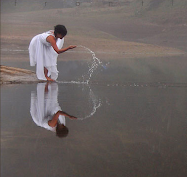Monday, August 20, 2012
E. San Juan on Filipinizing Cultural Studies
My firm conviction is that no indigenization project will fully succeed unless it includes a program of systematic decolonization, particularly an uncompromising indictment of U.S. colonialism/neocolonialism in its totality, together with its complicit transnational allies. Neither postcolonial hybridity, modernizing technocratic pragmatism, nor transnational flexibility will do; we need dialectical cunning and a bricoleur’s resourcefulness in taking advantage of what our forebears–Rizal, Recto, Agoncillo, Constantino, Hernandez, and others–have already won for us.
Thursday, August 09, 2012
Review of Verbal Arts in Philippines Indigenous Communities by Herminia Coben
Herminia Meñez Coben performs multiple roles in her book. First, she is a skilled
archivist—by painstakingly recording and collecting various poetic performances
in ten indigenous communities in the Philippines, she is able to transform the
ephemeral and the verbal into permanent print. Having said this, I am not claiming
a hierarchical and antagonistic relationship between oral and print cultures.
In doing this archival function, Coben offers scholars in anthropology, folklore,
performance studies, Philippine studies, and Southeast Asian studies a virtual
repository of valuable cultural practices. Secondly, she is an excellent scholar of
culture-in-action. She is able to provide the contexts in which these verbal arts are
practiced, performed, and reproduced. Looking into the social and political organization,
history, geography, and economy, Coben properly situates each group
within its own specific collective experience. Finally, having pointed to the archival
importance of this work, I want to stress that this book is not a non-theoretical and
uncritical catalogue of practices or a list of who, what, where, and when, but rather
a very ambitious analysis of persistent Southeast Asian island cultural themes and
semantic issues that cut across particular genres, performances, and communities
such as siblingship, gender, topography and place, and shamanic power.
Coben underscores the non-fixity of the verbal arts and the ways in which these
cultural productions are active processes engaged with ongoing political, economic,
and cultural struggles, and in many cases, are important media for social transformation
and change. Indigenous poetry, which is part of oratory skills, is something
that has been seen as an important ability and integral component of political and
religious leadership. Benedict Anderson in his classic article about power in Javanese
society showed how potency is embodied in oratory or verbal arts skills and
is crucial in understanding local forms of authority. Together with Anderson and
anthropologists such as Maurice Bloch, Coben ethnographically demonstrates the
structural powers of the verbal arts. However, I would like to augment this typical
reading with a different, albeit unorthodox, one.
I would like to depart from what would be a typical appreciation of a work such
as this and go more broadly into the emotional and affective elements in the verbal
arts. While Anderson, Bloch, and to some extent Coben have hinted at the energies
propelled by the skillful deployment of verbal forms and meanings, they nevertheless
have shied away from closer inspection of the emotional and affective ecologies
and climates that precipitate from indigenous poetic productions or performances.
Herminia Meñez Coben, Verbal Arts in Philippine
Indigenous Communities: Poetics, Society, and History
Manila: The Ateneo de Manila University Press, 2009. 402 pages.
Softcover, $19.50. isbn 978-971-550-583-3.
The Philippines
122 | Asian Ethnology 71/1 • 2012
Coben’s book opens up new ethnographic vistas for understanding the current
scholarly focus on affect and emotion. Affect is a fascinating analytical category
that allows for the recognition of the atmospheric effects of the sensorial—images,
scents, sounds, and haptic experiences. It also provides a way of acknowledging
bodily engagements that are not easily categorizable. Verbal poetic genres, particularly
those about love, anger, and violence, are in fact vital and vigorous vantages
for the conjuring of bodily affects and feelings. In fact, they are not literal positivist
records of “social facts” but are indirect lyrical and expressive renditions of
historical, cultural, and other social situations and are meant to persuade, entice,
and draw listeners and/or an audience into the spirals of the poetic narrative. The
reception of these indigenous poetic performances is dramatically more embodied
than everyday speech. While recent scholarly literature in the humanities and the
humanistic social sciences have pointed to the productive possibilities and potential
of bodily knowledge through affect and emotions, most if not all have focused
on Western-based media such as cinema, printed literature, and new media such
as the internet, and very little attention has been given to cultural productions in
indigenous communities. While this is not the author’s overt or explicit intention,
Coben’s analysis enables a productive alternative interpretation of the mechanics
of indigenous poetry as elements involved in the structuring of sentiments and the
conjuring of ecologies of passions, sensations, and feelings. In other words, I am
framing Coben’s book as a grounded staging of processes and practices that render
such ecologies and environments possible.
It may seem that this framework is inimical to Coben’s project, but I would
strongly argue that this appreciative though unconventional reading of her work
still remains true to her most basic intent—to demonstrate that indigenous verbal
arts are constitutive of cultural world-making. In sum, the richness of her data and
the erudition of her scholarly grasp of enduring research questions such as those of
potency and power in Southeast Asia will help in making this work an important
source and research touchstone for Asian studies scholars for years to come.
Martin F. Manalansan iv
University of Illinois, Urbana-Champaign
Subscribe to:
Posts (Atom)







